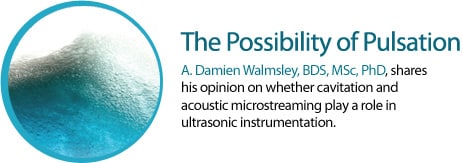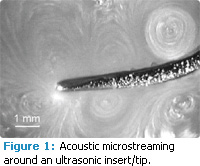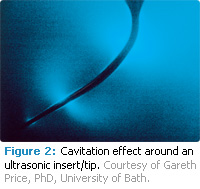
The Possibility of Pulsation
A discussion with A. Damien Walmsley, BDS, MSc, PhD, about cavitation and acoustic microstreaming in ultrasonic instrumentation.
The use of ultrasonic instrumentation has grown significantly over the past 20 years. Ultrasonic therapy is less taxing on clinicians’ musculature than hand instrumentation and offers the additional benefit of lavage. The ultrasonic scaler has proven effective in calculus and biofilm removal, but does it offer additional benefits? Some assert that the formation of pulsating bubbles (cavitation) and acoustic microstreaming (fluid flow generated by ultrasonic oscillations) created by ultrasonic scalers may have bactericidal effects. The discussion of cavitation and the possibility that it could disrupt dental biofilm began in 1984 when Dr. Walmsley’s paper “A Model System to Demonstrate the Role of Cavitational Activity in Ultrasonic Scaling” was published in the Journal of Dental Research.1 Because no in vivo research has been published on the topic, the debate over the role of cavitation and acoustic microstreaming continues. Dimensions of Dental Hygiene had the opportunity to speak with Dr. Walmsley about his thoughts on the subject.
How does an ultrasonic scaler work?
The ultrasonic scaler’s metal probe oscillates at high frequencies. It is the energy contained in this movement that disrupts microbial biofilms and fractures calculus deposits. This impact with the tooth may also lead to damaging effects, but these are avoided in the hands of well-trained operators who understand how the instrument works. While the ultrasonic instrument is operating, a flow of cooling water passes over the tip, reducing heat that might otherwise be problematic for vital teeth. As water flows across the ultrasonic tip, additional physical phenomena are observable—including cavitation and acoustic microstreaming.
What forces affect cavitation and acoustic microstreaming in ultrasonic instrumentation?

Acoustic microstreaming is another energy released around ultrasonic devices. This phenomenon is characterized by the movement of small currents in the water (Figure 1). Micro streaming commonly occurs around oscillating objects, such as cavitation bubbles or the scaler tip. These currents produce shear forces that are strong enough to break up clumps of bacteria but not powerful enough to break down bacterial cell walls.2 These forces have been shown to cleave flagella or other protuberances off bacterial walls. They are also able to break up colonies of bacteria and disrupt biofilm.3
What does cavitation look like?
It is possible to depict cavitation around ultrasonic instruments using various laboratory and photographic techniques. The intense energy released from within the bubbles can break down water or other chemicals.4 Luminol is a chemical that glows in response to this cavitation effect, allowing us to visualize what is taking place. Figure 2 illustrates that cavitation is most intense at the bend of a typical ultrasonic insert/tip (UIT) design. This image was taken with the instrument working freely within a water chamber. However, when the ultrasonic scaler contacts a solid surface, such as a tooth, the cavitation still takes place,5 although more studies are needed to verify the occurence and degree of cavitation. Further research is required to determine whether cavitation is occurring at the contact area between the tip and the tooth while it is moving within the periodontal pocket. It is also not known how or if the size, shape, or style of the UIT might affect this process. 
Early laboratory work demonstrated the removal of plaque from teeth by an action within the water that was not necessarily associated with direct contact of the tip against the tooth.6,7 This was attributed to cavitational activity and acoustic microstreaming, as both phenomena are interrelated.
What does the evidence say about the effects of cavitation and microstreaming?
Evidence of these effects by cavitation and acoustic microstreaming have only been demonstrated with in vitro research. More clinical research is needed because the contribution of such forces is not fully understood. Additional studies (including in vivo research) are necessary to understand possible clinical benefits. The attached biofilm may be disrupted by the streaming forces, which in turn allows for tissue healing. A greater evidence base is required with more randomized, controlled clinical trials to translate laboratory results into clinically-relevant outcomes.
What might the future hold in ultrasonic scaler technology?
Research should focus on whether and to what extent cavitation occurs in the periodontal pocket, and whether cavitation plays a role in removing biofilm from deep within periodontal pockets. It may be that the combination of the tip contact and the movement of fluid is what disrupts and dislodges the biofilm. A call was made at a recent international workshop for research to be conducted on the occurrence of cavitation in vivo and, if demonstrated, how it can be maximized to ensure that the biophysical phenomenon within the periodontal pocket is used to good effect.8 Based on laboratory studies, there is strong evidence that cavitation occurs. However, it is a difficult phenomenon to study clinically. New and improved imaging techniques will allow us to observe what is happening when using ultrasonic scalers in deep periodontal pockets. If cavitation and acoustic microstreaming do improve clinical outcomes, we may be able to develop ultrasonic technologies to maximize the potential advantage of these phenomena.
Acknowledgment
Dr. Walmsley wishes to thank the United Kingdom Engineering and Physical Sciences Research Council for grant numbers EP/C536894 and EP/F020090, in addition to Simon Lea, MSc, PhD, and Gareth Price, PhD, for support of this research.
References
- Walmsley AD, Laird WRE, Williams AR. A model system to demonstrate the role of cavitational activity in ultrasonic scaling. J Dent Res. 1984; 63:1162-1165.
- Schenk G, Flemmig TF, Lob S, Ruckdeschel G, Hickel R. Lack of antimicrobial effect on periodontopathic bacteria by ultrasonic and sonic scalers in vitro. J Clin Periodontol. 2000;27: 116-119.
- Baehni P, Thilo B, Chapuis B, Pernet D. Effects of ultrasonic and sonic scalers on dental plaque microflora in vitro and in vivo. J Clin Periodontol. 1992;19:455-459.
- Lea SC, Price GJ, Walmsley AD. A study to determine whether cavitation occurs around dental ultrasonic scaling instruments. Ultrason Sonochem. 2005;12:233-236.
- Felver B, King DC, Lea SC, Price GJ, & Walmsley AD. The generation of inertial cavitation around loaded ultrasonic scalers. Paper presented at: International Association for Dental Research; July 3-5, 2008; Toronto.
- Walmsley AD, Laird WR, Williams AR. Dental plaque removal by cavitational activity during ultrasonic scaling. J Clin Periodontol. 1988;15: 539-543.
- Khambay BS, Walmsley AD. Acoustic microstreaming: detection and measurement around ultrasonic scalers. J Periodontol. 1999; 70:626-631.
- Walmsley AD, Lea SC, Landini G, Moses AJ. Advances in power driven pocket/root instrumentation. J Clin Periodontol. 2008;35 (Suppl 8):22-28.
From Dimensions of Dental Hygiene. January 2012; 10(1): 42, 44.

